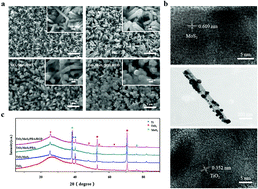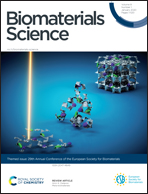Dual light-induced in situ antibacterial activities of biocompatibleTiO2/MoS2/PDA/RGD nanorod arrays on titanium†
Abstract
Prevention of bacterial infection and promotion of osseointegration are two important issues for titanium (Ti) implants in medical research. In addition, after a biofilm is formed on the surface of implants, the immune system and antibiotic therapy may fail. In this work, bio-functionalized titanium dioxide (TiO2)/molybdenum disulfide (MoS2)/polydopamine (PDA)/arginine-glycine-aspartic acid (RGD) nanorod arrays (NAs) are prepared on Ti implants to not only kill bacteria noninvasively upon co-irradiation of 660 nm visible light (VL) and 808 nm near infrared (NIR) light, but also promote the osteogenic activity simultaneously. Dual light irradiation triggers the TiO2/MoS2 NA to generate hyperthermia and reactive oxygen species (ROS) in 10 min. The synergistic effects of the generated hyperthermia and ROS increase the bacterial membrane permeability and bacteria are killed rapidly and efficiently in vitro and in vivo. The biofilm is also eradicated and RGD on the nanorods improves cell adhesion, proliferation, and osteogenic differentiation. The strategy described here for the design of bio-functionalized coatings on Ti implants has great clinical potential in orthopedics, dentistry, and other medical fields.



 Please wait while we load your content...
Please wait while we load your content...